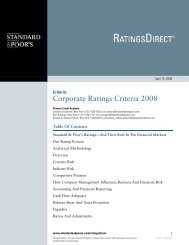European Infrastructure Finance Yearbook - Investing In Bonds ...
European Infrastructure Finance Yearbook - Investing In Bonds ...
European Infrastructure Finance Yearbook - Investing In Bonds ...
You also want an ePaper? Increase the reach of your titles
YUMPU automatically turns print PDFs into web optimized ePapers that Google loves.
PROJECT FINANCE/PUBLIC-PRIVATE PARTNERSHIPS<br />
124 ■ NOVEMBER 2007<br />
government’s financial position would be<br />
materially harmed if the shipping entity were to<br />
default. Government ownership of a shipping<br />
company and direct financial support mechanisms<br />
are also ways to link the rating on a shipping<br />
project more closely to that of the sovereign.<br />
As with project finance analysis, sovereign and<br />
institutional risks are assessed as well as<br />
credit enhancements.<br />
Could LNG ships have a rating above the<br />
underlying project rating?<br />
Typically the creditworthiness of the underlying<br />
LNG supply project will constrain the rating of<br />
the shipping deal. The two are inextricably linked<br />
in the value chain because the ships rely on the<br />
project to produce the LNG and the project is<br />
paying the charter fees. It might be possible,<br />
however, for the LNG shipping project to achieve<br />
a rating above that on the supply project if some<br />
delinkage is achieved from the underlying supply<br />
project. <strong>In</strong> this situation, we require comfort that<br />
the ships could earn sufficiently robust cash flow<br />
without the supply project, through either<br />
redeployment by obtaining long-term contracts or<br />
through the spot market. <strong>In</strong> this case, our charterhire<br />
price assumptions would be very conservative<br />
given the likely long-term nature of the debt. This<br />
situation might be more realistic in the long term<br />
than in the short-to-medium term, assuming that<br />
in the long term a deeper spot market develops.<br />
The current high amount of ships contracted for<br />
LNG projects, the lack of a deep LNG spot<br />
market, and the expectation that older-generation<br />
LNG ships might also be available for the spot<br />
market once their charter agreements end, all<br />
render unlikely the potential redeployment of the<br />
vessels at rates commensurate with servicing of<br />
debt under severely stressed scenarios.<br />
What recovery potential would you ascribe to<br />
LNG ships?<br />
Although we have not issued any public recovery<br />
ratings on LNG ship projects and continue to<br />
refine appropriate recovery scenarios, our analysis<br />
of recovery potential for LNG ship financings is<br />
likely to include an assessment of the<br />
redeployment of LNG vessels after a project<br />
default in a similar way to the process described<br />
above under a delinking approach. Given the<br />
STANDARD & POOR’S EUROPEAN INFRASTRUCTURE FINANCE YEARBOOK<br />
absence of any material sale and purchase market<br />
for LNG vessels, we would not typically ascribe<br />
much value to an enterprise value approach (such<br />
as using EBITDA multiples or net present values)<br />
when calculating our recovery ratings. Rather, we<br />
would likely focus our recovery analysis on the<br />
ability of the vessels to continue to service debt<br />
under low charter-hire rate assumptions, which<br />
could reflect historical lows witnessed in the spot<br />
market or long-term charter market or future<br />
lows anticipated in either market as appropriate.<br />
Do you view LNG ship projects with more than<br />
one vessel as less risky than single-ship deals?<br />
All else being constant, the greater the number of<br />
ships involved for a given financial profile, the<br />
greater the potential for higher ratings. Adding<br />
diversity can reduce operational risk as well as<br />
exposure to force majeure risk by having a safety<br />
cushion consisting of a residual operating fleet in<br />
the event that specific problems occur with some<br />
of the vessels. Although the LNG shipping<br />
industry has a very favorable performance record,<br />
the risk remains that some vessels might have<br />
their payment streams affected due to technical<br />
problems, political risk, or environmental<br />
conditions. The technical risk issue is present<br />
because LNG ships are becoming much larger to<br />
improve economies of scale and are employing<br />
reconfigured drive systems.<br />
If we were to hypothetically compare a<br />
standard single-ship project serving the same<br />
underlying LNG project (with all other risks<br />
remaining constant) with a multiple-ship project<br />
serving the same underlying LNG project, the<br />
chances are that rating would not be necessarily<br />
enhanced by having more ships. There would<br />
likely be more financial cushion at the same<br />
rating category for the LNG ship project with a<br />
higher number of vessels. The reason is that under<br />
the two different scenarios the credit quality of<br />
the same underlying LNG project continues to<br />
provide a constraint on the rating on the LNG<br />
shipping projects. Nevertheless, there could be<br />
examples where a ship project, because of its<br />
particular risk features, benefits by virtue of being<br />
structured with a large number of vessels, and<br />
therefore manages to achieve a rating above that<br />
of the underlying LNG project rating.



